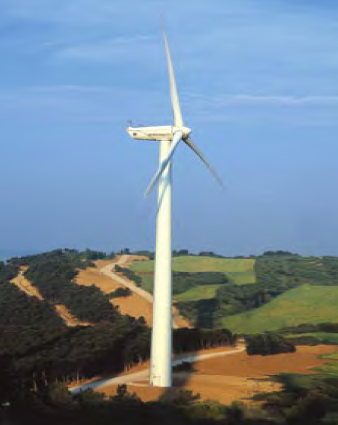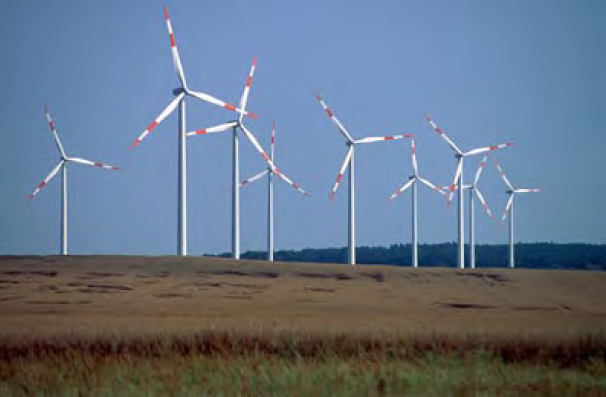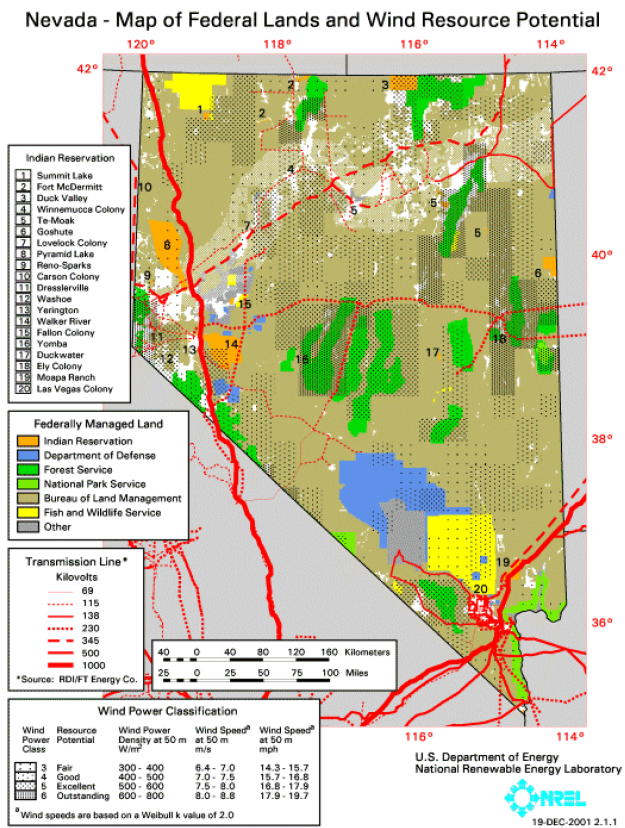What is Renewable Energy?
Renewable energy is result of natural atmospheric, geologic, and biological processes on the earth. Renewable energy sources include solar, wind, geothermal, and biomass. They are available in abundance in the western US and continually renew themselves, although they vary spatially and temporally within and between years. In other words, these energy sources can not be depleted. Heat and light from the sun, wind, thermal gasses, and organic waste can all be harnessed to produce electricity, power machinery and automobiles, while providing a cleaner environment, better air quality, and water availability in comparison to traditional fossil fuel energy sources.
Just over 50% of the power used in the western US is generated with fossil fuels. Fossil fuels include coal, natural gas, and oil, all of which are non-renewable energy sources. These fuel sources will eventually be depleted, causing the costs of these sources to increase dramatically as supplies fall. There are many environmental and public health costs associated with non-renewable energy sources as well. Coal and gas extraction often necessitate land and natural environment degradation. Additionally, fossil fuels used to operate power plants and generate electricity produce 40% of total US carbon dioxide emissions, 63% of US sulfur dioxide emissions, and 20% of US nitrogen oxide emissions, both causes of urban haze, brown clouds, and acid rain.
Why is Renewable Energy Development Important?
In addition to the health and environmental benefits of renewable energy sources, there are also economic related benefits. Many renewable energy development projects are completed in rural areas, which may lead to economic development in terms of new business generation and employment opportunities. For example, wind farms which use windmills to harness wind power and convert that power to electricity are often located in large open areas including range land, crop land, and mountain ridges. Additionally, renewable energy can provide reliable energy sources to rural areas where electricity was previously unreliable or unavailable.
Renewable energy will also reduce the longterm costs of power and stabilize energy prices due to its renewable nature. Market prices for energy as well as most other goods change in accordance with supply and demand forces. Renewable energy sources would provide a constant supply of energy, stabilizing energy prices. Studies show that renewable energy sources will be more than able to accommodate the increasing US population and its growing demand for energy in the western US.
Although the potential for renewable energy sources are great, there are currently many issues which must be addressed before these resources can be fully developed. These include, but are not limited to technology, transmission capabilities, and environmental impact studies.
The State of Nevada has abundant solar, wind, and biomass energy sources, but has a greater potential for geothermal energy production of any other state. In 2001, Nevada implemented the most aggressive renewable portfolio standard, calling for 15% of the state’s energy usage to come from renewable sources by 2013 (Senate Bill No. 372). This fact sheet is the first in a series of four publications, which provide an overview of renewable energy sources and current projects in Nevada, including resources for further information, and funding for renewable energy project development.

What is Wind Power?
Wind energy is really a result of solar energy. The sun’s radiation results in differing heat levels across the earth’s surfaces. Air rushing from areas of high pressure to low pressure, creates wind. The energy of these moving air molecules, called kinetic energy, can be converted into other forms of energy, including electricity.
Wind power has been utilized by people for many years to produce mechanical power for milling grain and pumping water. In recent years people have moved to harness wind power to generate electricity through the use of wind turbines. Wind power is one of the safest and cleanest of all renewable commercial methods of generating electricity.
Modern wind electric turbines are becoming a common sight in many rural areas of the US. While not as common as the traditional water-pumping windmills, their efficiency and applicability in rural areas is increasing. These large modern-looking machines efficiently convert wind into utility-grade electricity that can be used by communities, residential areas, businesses, and agricultural producers.
How is Wind Power Used?
The primary use of wind power today is the production of electricity. However, the wind industry has the potential to also provide secondary benefits apart from electricity production. Many landowners in windy areas are considering the possibility of leasing their land for wind farm development, or simply to produce their own power and/or sell excess capacity back to utilities.
The most economical utilization of wind power includes large groups of machines called “wind power plants” or “wind farms.” Generally these facilities involve individual machines capable of producing 600 kilowatts or kW, or more of electricity. However, smaller machines are available for individual operators. Wind energy, while not appropriate for every situation, can provide income diversification for individuals and communities through the production of electricity or, as mentioned above, by leasing wind rights on property.
The following terms are used to describe the electricity generating capacity of wind turbines. Electricity is measured in units called “watts”. Watts are commonly measured in kilowatts (kW=1,000 watts), megawatts (MW=1 million watts), and gigawatts (pronounced “jig-a-watt”, GW=1 billion watts). Electricity production and use by consumers is measured in kilo-watt-hours (kWh). A kilowatt-hour describes the electricity produced or used (1,000 watts) in one hour. A 50- watt light bulb that remains on for 20 hours consumes one kilowatt-hour of electricity (50 watts x 20 hours = 1,000 watt-hours = 1 kilowatt-hour).
A wind turbine’s output depends on the turbine’s size and the wind speed moving the rotor. Wind turbines currently range from 250 watts to 1.8 megawatts (MW). For example, a 10-kW wind turbine can generate approximately 10,000 kWh annually with wind speeds averaging 12 miles per hour. The average U.S. household consumes approximately 10,000 kWh annually. On the other hand, a 1.8-MW turbine can produce more than 5.2 million kWh in a year. This is enough for more than 500 households.

Are there Wind Power Projects in Nevada?
Nevada has excellent potential for electricity generation through wind power. Currently there are several anemometers in place to measure wind potential at various sites within Nevada. Figure 1 (last page) provides an overview of the wind power capabilities in Nevada. As shown in the Figure 1, northern Nevada, and in particular, north-central Nevada has the best potential. While this is true for large commercial wind farms, small individual operators may still benefit from single turbine machines to power residences and/or farming/ranching operations given appropriate economic conditions.
While there are no current wind power generation projects in Nevada, there are several proposed projects. Cielo Wind Power at Desert Queen Wind Ranch in Ainsworth, Clark County has proposed to install an 80MW capacity facility by 2005. Carlson & Associates in conjunction with Ely Wind in White Pine County have proposed a 50 MW capacity installation by 2005 as well. There are also two competing proposals currently in the planning stage for construction of wind projects near the town of Gerlach in northern Washoe County. While these two projects also encompass coal and geothermal sources, wind power is part of both proposals.
Where Can I Find Funding for Wind Power Projects?
Grants
USDA-Rural Development: This grant authorized by the 2002 Farm Bill, provided funds ($22.8 million in 2004) to ranchers, farmers, and rural small business for renewable energy projects, including wind, solar, biomass, and geothermal sources. Grant funds, which can be used for up to 25% of total project costs, are awarded annually.
Rebate Programs
There are a number of rebate programs in Nevada, including business and personal property tax rebates, sales tax rebates, and utility bill rebates. The Federal Government also provides rebates including corporate tax credits and clean-fuel vehicle tax deductions. Federal loan programs include the Energy Efficient Mortgage and the Energy Star Financing programs. A complete listing of all State and Federal programs is available at DSIRE.
Where Can I Find Additional Information?
Web Resources
- American Wind Energy Association: ACP
- Clean Energy, Winrock International: Winrock
- Nevada State Office of Energy: NV Energy
- U.S. Department of Energy, Wind Energy Program: GOV Energy
- U.S. Department of Energy, Wind Powering America Initiative: Wind Energy
- U.S. Department of Energy, National Renewable Energy Laboratory, National Wind Technology Center: NREL
Wind System Contractors/Providers Alternative Energy Systems, Inc.
300 W. Utah Ave. Suite 101
Las Vegas, NV 89102
702-262-9463
D & L Henson Enterprises
2433 E. Tropicana #354
Las Vegas, NV 89121
702-269-4478
AMI International
206 Black Eagle Ave.
Henderson, NV 89015
702-564-9186
Alternative Energy Solutions
195 N. Edison, Suite 16
Reno, NV 89502
775-857-1157
Scott Campbell Electric, Inc.
4001 S. Decatur 37-112
Las Vegas, NV 89103
702-431-4797
References
- American Wind Energy Association. Wind Energy Fact Sheets. Washington, D.C. ACP.
- Dodge, Darrel. Illustrated History of Wind Power Development. Littleton, CO. Telosnet.
- Nielson, John, Susan Innis, Leslie Kaas Pollock, Heather Rhoads-Weaver, and Angela Shutak. Renewable Energy Atlas of the West: A Guide to the Region’s Resource Potential. A project of the Hewlett Foundation and The Energy Foundation. Produced by Land and Water Fund of the Rockies and Northwest Sustainable Energy for Economic Development.
Figure 1. Nevada Wind Power Potential

Curtis, K., Breazeale, D., and Riggs, W.
2004,
Nevada’s Renewable Energy Resources: Wind,
Extension | University of Nevada, Reno, FS-04-53


